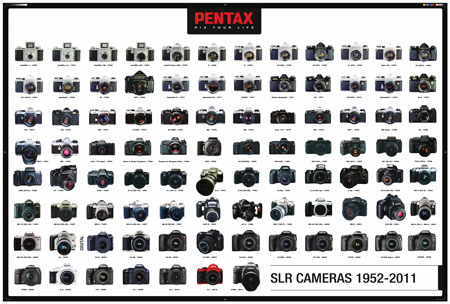Pentax is a lone wolf out there, the plucky underdog. Swallowed by Ricoh in 2011, Pentax kept on churning out slowly what they always did best: solid, resilient gear, not top of the line, but innovative in its own right, practical, sturdy, and with its K mount compatible with a huge array of lenses — more than 215 to be exact produced since the founding of Pentax. Pentax can count on loyal users, even though the company has gone from a major force in photography to become a shadow of its former self. They do many things right, like choosing the right in-body image stabilization. This stuff doesn’t belong in lenses where it only adds price and weight. This makes every Pentax lens a stabilized lens. Yet, Pentax lacks traction. What is it that keeps Pentax back from breaking out of its wallflower existence?
Pentax, which invented SLR structure and autofocus, had a great history in the last century. Even today the lineup is not unimpressive:
- Pentax 645Z is many photographers’ medium format of choice in terms of quality and value. Outdoes CaNikon’s top cameras in many aspects and is a serious challenge to Hasselblad and Phase One.
- Pentax K-1 is a full-frame camera offering premium value for much less buck than the competition, just to mention the K-1’s 36MP, in-body stabilization, Pixel Shift Resolution mode and in-body illumination for intuitive camera operation, etc.
- Pentax K-3 II costs about half of the CaNikon equivalents, is waterproof and the solid build quality is just in another league.
Granted, sometimes Pentax overdid it a bit. The Pentax Q is more of an 007 wannabe fashion gimmick with the tiniest sensor, and who can ever forget the colorful K-01 designer brick.

Overall, however, Pentax offers top of the line camera gear with world class optics at unbeatable prices. Build quality is top-notch, I’d seriously consider buying into the system would I be in the market for a new one. But Pentax is not visible.
Pentax is an insider brand, something inherited, something recommended from friend to friend, and yes indeed they don’t offer what CaNikon does for sports and wildlife photography with fast telephoto glass. And people want fast and accurate autofocus.
Pentax is not imposing itself upon photographers with big expensive marketing campaigns. Ricoh has been good to Pentax, but they’re not thinking beyond the land of the rising sun. Pentax lacks an all-over distribution network, they are very Japan-focused and even big camera stores don’t always stock them up. Pentax doesn’t find you. You have to find them, and that’s a problem in today’s world of monopolies and duopolies (CaNikon again). A second layer of camera makers with Sony, Olympus and Fujifilm is making some inroads, but then again, Fujifilm’s most sold cameras are… Instax cameras, while sales of digital cameras shrink.
In the complex third layer we have Pentax and the rest, with Pentax still not offering a mirrorless solution, well the Q… And isn’t that where the future is. Pentax was once, can you believe it, the biggest selling camera brand. They slept away the digital era, but then again, look what happened to Kodak or Nokia for that.
One can always hope Ricoh starts pushing Pentax. They’d have the deep pockets. Ricoh nearly has the turnover of Canon and Nikon combined. And lest we forget, Ricoh brings the one-of-a-kind Ricoh GR to the table, a favorite camera of many photographers I know. But Pentax can’t compete on underdog-branding and price alone. Highlighting differentiation is challenging in today’s highly competitive market environment of ample consumer choices.
Pentax quo vadis. The niche player’s problems have much to do with perception. They need visibility, professional endorsement — or another merger (hello Samsung!). Or maybe speed up things a bit. They just released the full-frame K-1, way after everyone else. Mirrorless full-frame? Wouldn’t solve Pentax’ traction issues. Could cause analysis paralysis among potential buyers, leading to more camera phone sales.
Pentax will just keep on hanging in there, always a step behind the competition, protected by multinational Ricoh, and that’s not a bad thing. No experiments, no unproven technology, what you get just works. Gear to last, no monies spent on overpromising marketing budgets. Again, if I’d be in the market for a system, I’d pay especially the K-1 a close look.


